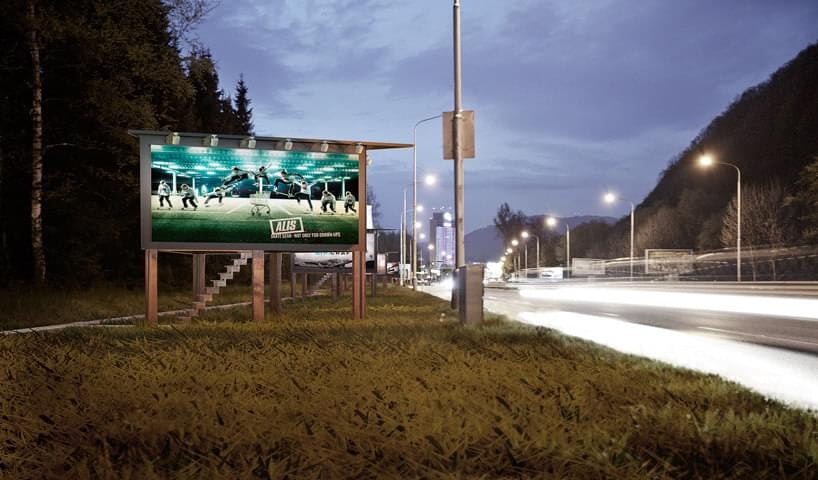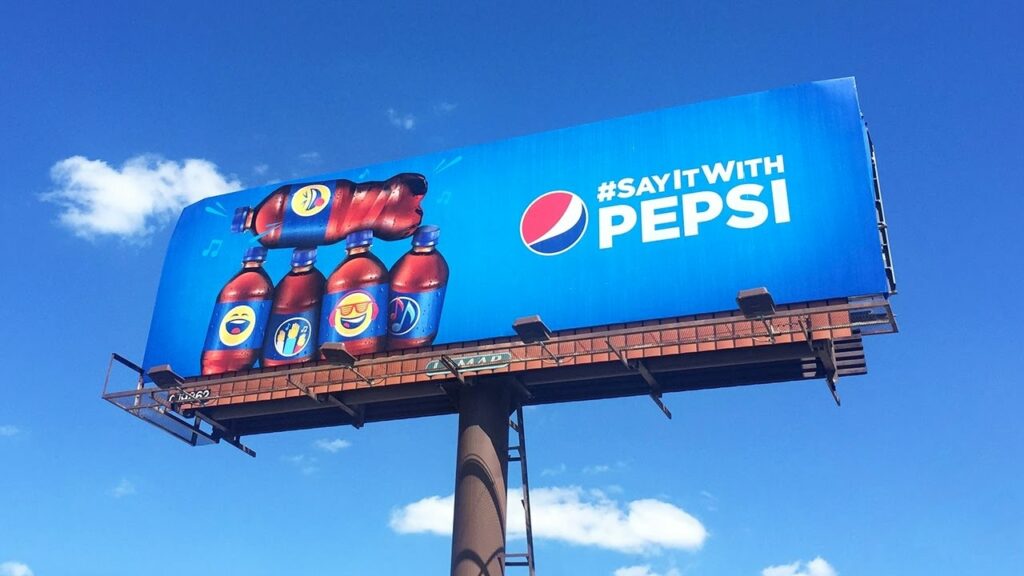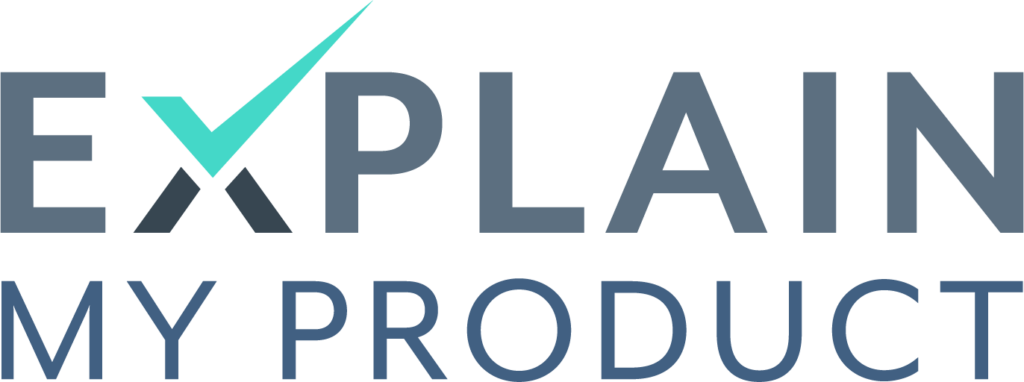It’s both boring & dynamic. But if there was ever a time to get in, it’s now.
This week’s issue is about an investment opportunity that is far away from most people’s radar: The unsexy but comfortable and cashflow-consistent world of billboards.
Let’s dive in!

Table of Contents
A nation of billboards
Before we begin, it must be said that I’m not actually a big fan of billboards. One of my favorite aspects of living in Santa Barbara was how the city flat-out banned them. They realized any incremental revenue gained would be far overshadowed by the cost of ruining the gorgeous views for everyone.
However, I understand billboards have a place in society, and quite a large one at that. You cannot drive for very long anywhere in the world and not see them. They are everywhere.
How many billboards are there in America?
When you think of a billboard, you probably think of a big sign along the side of the highway. But to the ad industry, billboards are just one part of the “out-of-home” advertising medium, which includes public display vehicles such as subway ads, bus shelters, aerial ads & blimps, gas station pump screens, even ads on the back of street sweepers.
America has roughly 340,000 billboards, a figure that has been mostly flat over the past 5 years. Interestingly, just 2.8% of billboards are digital. The vast majority are analog — those classic steel or wood constructions that date back to the civil war — and there’s a big digitization opportunity we’ll get into a bit later.
Three big players
There are three billboard companies in America that collectively share 60% of the market:
- ClearChannel Outdoor is the market leader. They were spun off from iHeartMedia in 2019 as part of a plan to exit bankruptcy, and are now trading independently.
- Lamar Advertising is actually a REIT which operates throughout the US & Canada.
- Outfront Media, another REIT, is the youngest of the three. A few years ago they refused to run some underwear ads, because “period” was used in the copy, accompanied by (racy) images of grapefruits.
Billboard growth & decline
Pre-COVID, out-of-home advertising spend was growing at around 5-7% YoY. Money was moving into billboards from newspapers, radio and even TV. Post-COVID, it’s been another story. Because the medium is notoriously difficult to track & prove ROI, it’s often the first ad market that is jettisoned in a recession.
Previous downturns have shown that billboard industry suffers at 3x the general economy on the downside. But given the global lockdowns, nuked travel sector, and impeded mobility, this recession has hit extremely hard. The industry is currently down 21% YoY. These are very dark times for the big three, as well as for independent owner-operators, who have slashed prices up to 95%.
But just like recessions offer good opportunities for scooping up distressed websites, real estate, or other or assets, right now is probably the best time in decades to consider getting into the billboard space.
So how do you make it happen? Read on…
Sponsored
Need quick feedback on your site?
ExplainMyProduct is a way to get free online user testing for your website, landing page, or mockup.
ExplainMyProduct reviewers don’t hold back. They identify your blind spots and uncover hidden biases. They’ll let you know what resonates, what needs refinement, and what isn’t working at all.
You have one chance to make a good first impression. Get honest, unbiased feedback delivered within 72 hours.
Why invest in billboards?
Owning a billboard is kind of the perfect alternative asset. It’s ultimately a simple business model: Build (or buy) a board, sell ads, collect revenue. At that point, you’re ultimately running a sales organization.
Collections are steady (although local suppliers pay quicker than national advertisers), and bad debt issues are rare. It provides a regular income cash flow with very healthy margins. EBITDA margins can reach up to 40 – 50 percent for well-placed boards.
Physical billboards typically yield between $750 -$3,000 per month, depending on the market. Digital billboards can get you anywhere from $1,200 up to $15,000+ per month.
It has high ROI and low competition. As a guest on the Billboard Insider Podcast noted, this business is both boring and dynamic: Boring because of consistency of cashflow, and dynamic because of the opportunity for digital sign conversions.
How to invest in billboards
It’s great once you’re up and running and earning a 40% return. But getting there takes considerable effort.
Securing a lease
Do you happen to own a large stretch of vacant land adjacent to a major road? No? Then you’ll need to buy or lease the land.
It’s pretty rare for billboard investors to own land outright anymore. All the good spots are pretty much taken, and as the saying about land goes, “they ain’t making any more of it.”
So the common practice is to secure a ground lease with an existing property owner to build and maintain a billboard on their land. The big companies are constantly doing exactly this. A significant part of their operations is actively seeking new, prime locations for billboards, and entering into long-term leases with landowners for exclusive use of their land.
Permitting and legal issues
The challenges you face securing land are likely nothing compared to getting a permit. In fact, this step is so critical and difficult that this is really the only place to begin.
The same barriers to entry that make this this investment space so attractive are also what make it so difficult to get going. You need a permit to build a billboard, and it’s not easy.
This isn’t like Uber skirting regulations and asking for forgiveness later. Ever since the Highway Beautification Act in the 1960s, roadside advertising has been a highly regulated space. The federal government limits the supply of interstate billboards to certain spacings and zonings, and state & cities can exert even greater levels of control should they so desire.
Regulation is high, and the playing field is limited by design. Look into local ordinances to confirm they’re permitted under local zoning regulations. (Just because you see existing billboards on a freeway doesn’t mean they’re allowing more — the total number is likely capped.) After finding a suitable area, you’ll need to call the local city or county government, get a zoning map, and start putting the pieces together.
The process typically takes years. Prepare for a long, bureaucratic, frustrating marathon of paperwork, headaches, and legal fees.
Digital billboard conversion
One strategy investors are now employing is offering to convert analog billboards to digital. Cities are becoming increasingly fond of digital billboards that they can use to spread news about community events, advocate city services, and promote public safety messages during, say, a pandemic. (This is a core part of the “Smart Cities” movement.)
While city councils are often extremely reluctant to give out new permits, they may let you convert existing billboards into digital screens (especially if you remove 18 static billboards as part of the deal.) But conversions can be quite cost-prohibitive.
Billboard construction costs
Permitting is the tough part. Once you have a permit, building the structure is much easier by comparison, and probably isn’t all that expensive.
The cost completely depends on the type of billboard that you are constructing. Key factors here are size, materials used, and height.
There are 4 primary types of billboards: wooden, metal, monopole, and digital.
Wooden billboards
Wood is the cheapest. Traditionally, wooden signs sit low to the ground, and don’t contain catwalks. Some may not even include ladders or lights. Wooden billboards typically cost between $2,000 and $10,000.

Metal billboards
Metal structure allows for larger displays. 12’ x 24’ is the standard metal billboard size, and although boards of this size can be attached to wooden poles, investors usually prefer steel.
These usually contain a catwalk and are typically raised 12’ off the ground to discourage vandalism. These typically cost between $20,000 to $30,000 to install.

Monopoles
Once you get into the larger sizes (14’ x 48’) you’ll need what’s known as a monopole, or unipole.
These are the boards you see along freeways, and are the most difficult and expensive to build by far. They are full of catwalks, ladders, and big bright lights. They can rise over 100 feet high, and require sophisticated engineering to bring to life.
These types of billboards run from $30k – $75k for single-faced monopoles (those that display ads on just one side) to $60k – $100k for double-faced (those that display on both sides)
Don’t forget there’s a significant cost to just placing the ads themselves. Putting up and taking down ads requires a team of people climbing great heights. A number of billboard companies offer placement & takedown services.

Digital billboards
Digital, or LED billboards, are the most expensive by far. Investors like them because ad switching is a cinch, and it allows them to earn more per impression
But setup is highly complicated, and what you save in ad switching costs is immediately sucked up by higher electricity bills. The cost to install digital billboards typically exceeds $100,000 for mid-sized metal installations. For double-faced monopoles with giant LED screens, you’re looking at up to $1 million all-in.
Other Expenses and risks
Maintenance
Maintenance costs are typically low. You build the sign once, and rent the ad space typically once per year. You have to deal with the usual suspects inherent to any outdoor structure, including storm damage, vandalism (billboards are infamous for attracting taggers), burnt-out lights, and cleaning up of bird shit.
Depreciation and maintenance is higher with digital billboards. Pixels go bad, new sharper image technology gets released, and in rare occasions the entire control panel faults, causing your board to look like the monolith from 2001: A Space Odyssey.
Leasing costs
The ground lease is the largest expense. The typical total expense ratio on a billboard’s gross rent is roughly 40%. So a double-faced billboard that rents for $1,000 per month would pay $9,600/year for the lease, and have an annual net income of $14,400 ($1,000 x 2 faces x 12 months x 0.6)
Operation costs
Minimal. You’re biggest operational cost is labor, mostly your sales team, which typically works on commission anyways.
Day-to-day billboard management is essentially an entry-level admin job, and new billboard management software has rendered most of those jobs irrelevant.
Billboard financing
Since banks are typically hesitant to lend to unproven billboard investors, capital is usually raised via funds which specialize in out-of-home advertising.
However, a new class of lending companies have sprouted up to help first-time investors finance their purchase and operations. Stark Capital Solutions works with owner-operators to build, buy, or do digital conversions.
Sponsored
???? Unique gifts worth exploring
Looking for a unique gift this season?
Every day Mugwomp finds the best products from across the Internet and curates them for you.
It’s the Internet’s best-kept secret. Well, one of them, anyways.
But seriously, don’t buy another gift card. Get inspired and find something cool!
You definitely need a little Mugwomp in your life.
Buying and selling billboards
Similar to buying websites & digital assets, buying a pre-existing billboard saves you the time and stress of having to build it yourself.
Billboard buying, selling, and flipping is quite common. Multiples average around 10x annual gross revenue, or 5x annual net profit.
The big three often buy & sell to each other to place future bets or offload debt. In 2016 Lamar Advertising purchased the advertising rights in five major American cities from ClearChannel for $458.5 million.
There are billboard valuation services, billboard brokers, and a growing set of billboard consultants. Frank Rolfe is one of them. He built the largest privately-owned billboard company in Dallas from scratch, and has a killer blog with some absolutely fantastic tips for buying billboards during recessions. (TL;DR — Next time you see a dilapidated, worn-out billboard alongside a rural road, find out who owns it and offer to buy it outright, or offer to bring it back to life for free in exchange for a majority equity stake!)
Some newsletters I like
That’s it for the billboard chatter. It’s a great topic, but I’m about to run out of room on this email.
Before I do, I wanted to take a moment and give a shoutout to a few Alternative Assets subscribers whose newsletters I really enjoy:
- Jakob Greenfield has a short but sweet newsletter called Product Ideas, which gives you just enough content to motivate and force you to think outside the box. He also created ProductExplorer — a live database that helps you discover undervalued assets. Check it out.
- Ana Milicevic is the co-founder of Sparrow Advisors. Her newsletter is a must-read for anyone in the advertising space. She recently wrote an in-depth piece on Dotdash, a massive content website publisher that website investors will want to pay attention to.
- Finally, David Nichols started The Land of Random to help “rediscover the magic of the Internet.” His newsletter doesn’t take itself too seriously, which I love. It’s chock full of cool finds that aren’t engineered for virality.
How’d you like this issue?











